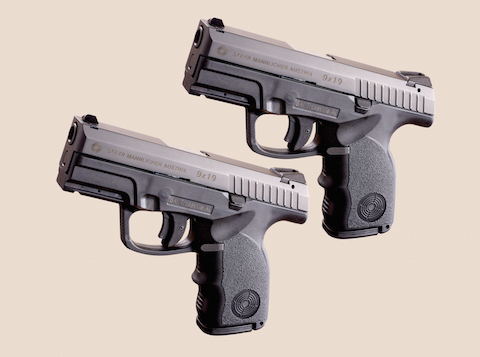
The case for buying two identical concealed carry guns. You can thank me later.
It’s quite popular in the world of concealed carry (CCW) and defensive shooting to say that “all guns break”. As I’ve said before, that’s true — but some guns break more commonly, more predictably, than others.
However, even the best and most reliable gun, like the most reliable automobile, becomes less so as the round count (or the mileage) accumulates. That’s just a fact of life; all mechanical devices experience wear over time, it’s just that some of them handle that wear a little better than others. Still, sooner or later wear catches everything.
Proper maintenance, of course, goes a long way. Many years ago I worked with a fellow who purchased a new pickup, one which was built in Japan and sold in this country under both its manufacturer’s nameplate and the nameplate of the American car company which imported it and badged it as their own. Other than trim levels, they were identical.
The funny part is that, according to one magazine which tracked such things back then, one version of the truck had a superlative repair record while the other version had an abysmal record. Same engine, same drivetrain, same body, different paint and wheels — and a radically different repair record.
Why? One of the brands sold to people of, shall we say, lesser means than the other. They couldn’t afford the two-tone paint jobs and inflated prices of the American label, so they bought the monotone Japanese brand with the hubcaps instead of the styled wheels. They also, apparently, couldn’t afford to maintain their vehicles to the same standard their more well-off cousins could, which accounted for the stark difference in reliability.
Even the best device will become unreliable with poor maintenance. Maintain it properly and you’ll extend its life, but eventually everything starts to have issues.
So, what does this have to do with your carry pistol? A lot, actually.
As you shoot your gun you wear it out. Parts come a little closer to breaking, springs weaken, detents don’t hold as well, grooves are formed in moving parts. Perform the right periodic maintenance — replace the springs on occasion, check for damage and wear and replace those parts which show any — and you’ll extend the life of that gun. If the gun is known for particular issues with particular parts, keep spares on hand and change them more regularly.
Nothing is forever, though, and it’s possible to shoot a gun to the point that things just get loose enough that reliability can suffer. The problem is that malfunctions due to wear aren’t always predictable; one day the gun runs perfectly, and the next time at the range it can’t feed or a part breaks and the slide no longer locks open on an empty magazine. Sometimes things (like trigger springs) can just break and the gun doesn’t work (happened to me once with a very expensive German gun known more by its initials than its name. I’m not going to tell you what company that was, because in their minds you suck and they hate you.)
Of course keeping spares on hand and doing regular maintenance are great, but as a gun gets used the chance of needing those spares goes up. As long as you don’t absolutely need that gun to work when you pull it from the safe (or your holster), you’re in good shape. If, however, it’s a defensive tool and working when you pull the trigger is sort of why you have it in the first place that’s no longer acceptable.
As it happens, training regularly and thoroughly is a great way to put a lot of wear on a defensive firearm. You’ll quickly go through thousands of rounds of ammunition, sometimes under rough conditions, and you’ll definitely bang that gun around. Just as city miles are harder on a car than highway miles, training rounds are rougher on a gun than sedate target shooting rounds.
So you have two competing interests: the desire to have an absolutely reliable firearm on your person or in your quick-access safe, and the desire to get out and train and practice with that firearm. The two interests will eventually collide.
In the car world, when that happens you usually trade the vehicle off and get another. That’s always a possibility in the firearm world too, but there is another alternative — and one that’s a lot easier than it is for automobiles: buy two identical guns.
Now I know some of you just stopped reading and let out a loud “whoop”, showed this to your significant other and yelled “see, I told you I needed another gun, and this guy says I definitely do! Can’t argue with that, can you??”
I’d encourage to continue reading, however, because there’s more to this than satisfying your acquisitional lust. There is method to my madness.
Once you’ve decided that you like a particular gun and will carry it for a long period of time, it makes sense to buy a second one. The first one, which you’ve probably had long enough to break in and verify reliability but not long enough to really wear out, becomes your carry gun. It is kept clean and babied, shot occasionally to verify functioning and then put back on your belt (or wherever you carry it.) Of course you take it apart now and again to clean out and replace the oxidized oils and greases as well as getting rid of the inevitable carry grime.
That second gun, the new one, becomes your practice and training piece. (If you’ve had that first one long enough to put several thousand rounds through it, the roles are reversed and the new one is your carry piece — after thoroughly testing for reliability with your carry ammunition, of course.)
The idea is to put all of the hard wear on the training gun. It’s the one that gets thrown around on the range, the one that has the high round counts, the one that gets parts replaced because they break — but because it’s dedicated to the training role, never in a situation where that breakage endangers you.
By doing this you get the best of both worlds: a reliable, trusted gun to carry and use for your personal defense, and one you can train with to build your skills to be able to do so responsibly.
Yes, it’s going to cost you twice as much. There are just some things even I can’t fix.
-=[ Grant Cunningham ]=-
- Posted by Grant Cunningham
- On March 26, 2015



